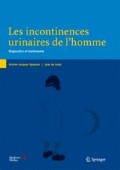Résumé
-
Les troubles fonctionnels vésico-sphinctériens sont fréquents chez l’enfant.
-
Une stratégie thérapeutique peut être proposée sur base d’un bilan non invasif.
-
Ces pathologies pédiatriques peuvent réapparaître chez l’adolescent et chez l’adulte et sont dès lors de mauvais pronostic.
Preview
Unable to display preview. Download preview PDF.
Références
Mattsson S (1994) Urinary incontinence and nocturia in healthy schoolchildren. Acta Paediatr 83(9): 950–954
Hjälmäs K (1992) Functional daytime incontinence: definitions and epidemiology. Scand J Urol Nephrol Suppl 141: 39–44; discussion 45–6
Swithinbank LV, Carr JC, Abrams PH (1994) Longitudinal study of urinary symptoms in children. Longitudinal study of urinary symptoms and incontinence in local schoolchildren. Scand J Urol Nephrol Suppl 163: 67–73
Sureshkumar P et al. (2000) Daytime urinary incontinence in primary school children: a population-based survey. J Pediatr 137(6): 814–818
Muellner SR (1960) Development of urinary control in children: some aspects of the cause and treatment of primary enuresis. JAMA 172: 1256–1261
Franco I (2007) Overactive bladder in children. Part 1: Pathophysiology. J Urol 178(3 Pt 1): 761–768; discussion 768
Yeung CK et al. (1995) Some new insights into bladder function in infancy. Br J Urol 76(2): 235–240.
Kavia RB, Dasgupta R, Fowler CJ (2005) Functional imaging and the central control of the bladder. J Comp Neurol 493(1): 27–32
Neveus T et al. (2006) The standardization of terminology of lower urinary tract function in children and adolescents: report from the Standardisation Committee of the International Children’s Continence Society. J Urol 176(1): 314–324
Vemulakonda VM, Jones EA (2006) Primer: diagnosis and management of uncomplicated daytime wetting in children. Nat Clin Pract Urol 3(10): 551–559
van Gool JD et al. (1992) Historical clues to the complex of dysfunctional voiding, urinary tract infection and vesicoureteral reflux. The International Reflux Study in Children. J Urol 148(5 Pt 2): 1699–1702
Akbal C et al. (2005) Dysfunctional voiding and incontinence scoring system: quantitative evaluation of incontinence symptoms in pediatric population. J Urol 173(3): 969–973
Farhat W et al. (2000) The dysfunctional voiding scoring system: quantitative standardization of dysfunctional voiding symptoms in children. J Urol 164(3 Pt 2): 1011–1015
Upadhyay J et al. (2003) Use of the dysfunctional voiding symptom score to predict resolution of vesicoureteral reflux in children with voiding dysfunction. J Urol 169(5): p 1842–1846; discussion 1846; author reply 1846
Olbing H (1992) Management of the incontinent child in general practice. The paediatrician’s viewpoint. Scand J Urol Nephrol Suppl 141: 126–134
Mandell J et al. (1980) Occult spinal dysraphism: a rare but detectable cause of voiding dysfunction. Urol Clin North Am 7(2): 349–356
Hoebeke P et al. (1999) Anomalies of the external urethral meatus in girls with non-neurogenic bladder sphincter dysfunction. BJU Int 83(3): 294–298
Yeung CK et al. (2004) Ultrasound bladder measurements in patients with primary nocturnal enuresis: a urodynamic and treatment outcome correlation. J Urol 171(6 Pt 2): 2589–2594
Griffiths DJ, Scholtmeijer RJ (1984) Place of the free flow curve in the urodynamic investigation of children. Br J Urol 56(5): 474–477
Hjälmäs K (1988) Urodynamics in normal infants and children. Scand J Urol Nephrol Suppl 114: 20–27
Hellström AL, Hjälmäs K, Jodal U (1987) Rehabilitation of the dysfunctional bladder in children: method and 3-year follow up. J Urol 138(4): 847–849
Vijverberg MA et al. (1997) Bladder rehabilitation, the effect of a cognitive training programme on urge incontinence. Eur Urol 31(1): 68–72
Hoebeke P et al. (1996) Outpatient pelvic-floor therapy in girls with daytime incontinence and dysfunctional voiding. Urology 48(6): 923–927
Abrams P et al. (2003) The standardisation of terminology in lower urinary tract function: report from the standardisation sub-committee of the International Continence Society. Urology 61(1): 37–49
Opsomer RJ, Wese FX, Dardenne AN, Van Cangh PJ (1990) Posterior urethral valves in adults males. Urology 36: 35–37
Schober JM, LM Dulabon LM, CR Woodhouse CR (2004) Outcome of valve ablation in late-presenting posterior urethral valves. BJU Int 94(4): 616–619
Mallouh C (1993) Urethral valves: unusual presentation in 14-year-old boy. Int Urol Nephrol 25(3): 235–237
Afshar K et al. (2007) Spinal cord magnetic resonance imaging for investigation of nonneurogenic lower urinary tract dysfunction-can the yield be improved? J Urol 178(4 Pt 2): 1748–1750; discussion 1750–1
Arikan N et al. (1999) Role of magnetic resonance imaging in children with voiding dysfunction: retrospective analysis of 81 patients. Urology 54(1): 157–160; discussion 160–1
Mayer M (1990) Potentiels évoqués et électromyographie en pédiatrie. Masson Collection ABC, Paris
Opsomer RJ, Abi Aad A, Jamart J et al. (1989) Vibratory and electrical sensibility thresholds in adults and in children. NeuroUrol Urodyn 8: 322–323
Opsomer RJ, Guérit JM, Mayer M (2006) Electrophysiology. In: Esposito C, Guys JM, Gough D, Savanelli A (eds) Pediatric neurogenic bladder dysfunction: Diagnosis, Treatment and Long-term follow-up, Springer Verlag, Berlin — Heidelberg, chp 17, p 147–152
Opsomer RJ, Kerdraon J (2006) Exploration neurophysiologique des fonctions sphinctériennes. In: Amarenco G et Chantraine A (ed) Les fonctions sphinctériennes, Springer, Paris, p 151–160
Author information
Authors and Affiliations
Rights and permissions
Copyright information
© 2011 Springer-Verlag France
About this chapter
Cite this chapter
Hoebeke, P., Opsomer, R.J. (2011). Les pathologies pédiatriques fonctionnelles : bilan et diagnostics. In: Les incontinences urinaires de l’homme. Springer, Paris. https://doi.org/10.1007/978-2-287-99160-8_23
Download citation
DOI: https://doi.org/10.1007/978-2-287-99160-8_23
Publisher Name: Springer, Paris
Print ISBN: 978-2-287-99159-2
Online ISBN: 978-2-287-99160-8
eBook Packages: MedicineMedicine (R0)

